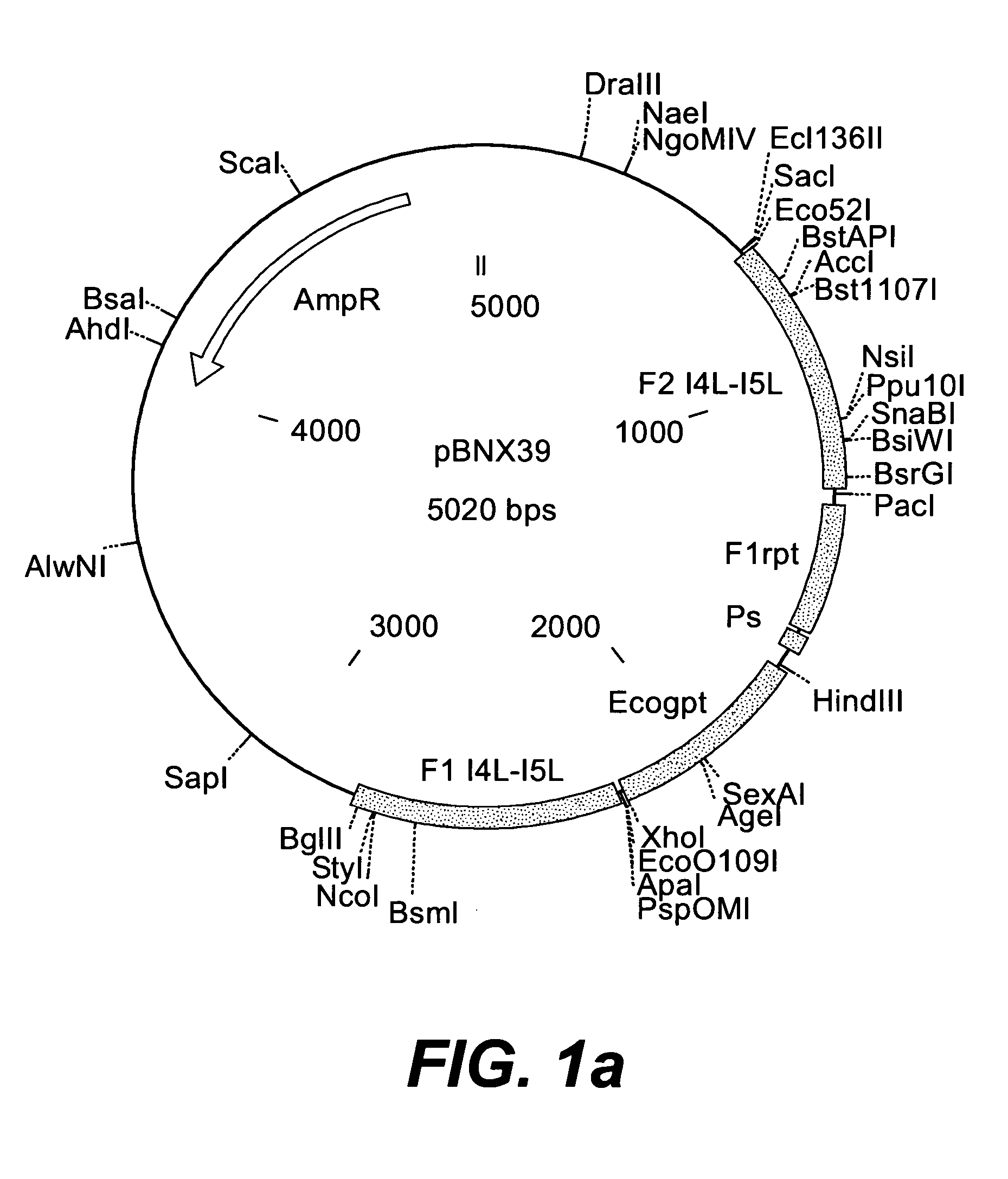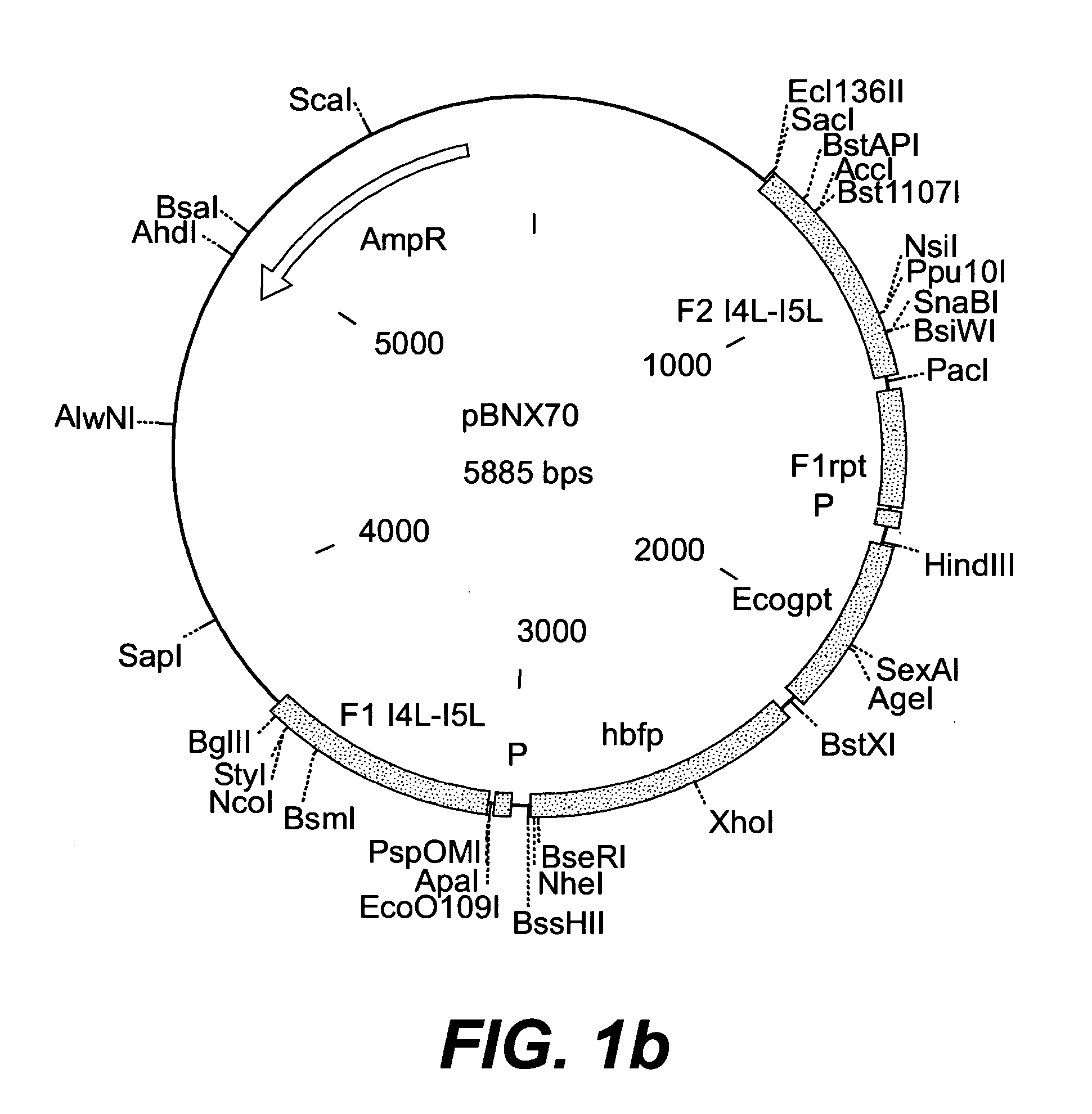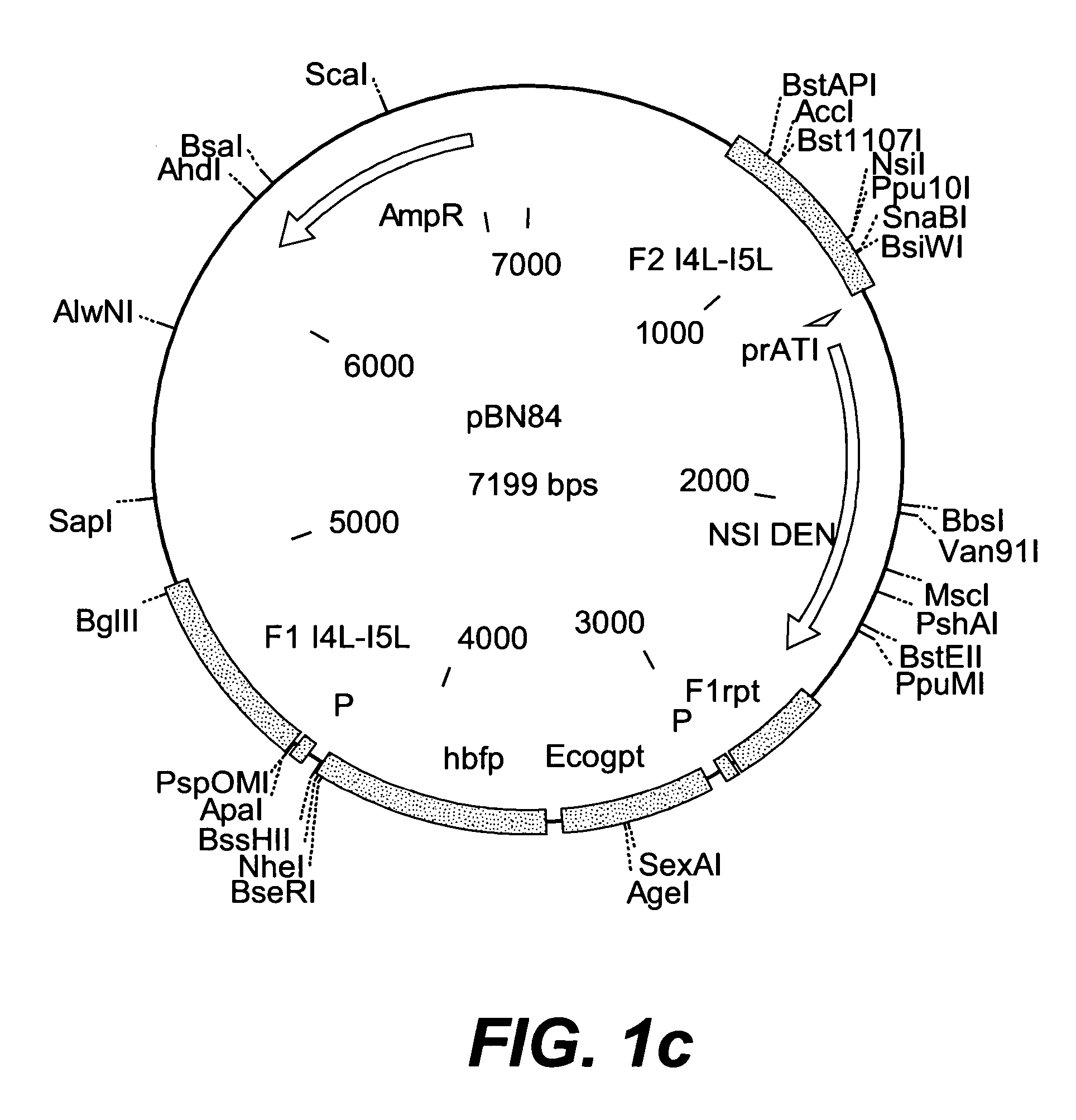Intergenic regions as novel sites for insertion of HIV DNA sequences in the genome of Modified Vaccinia virus Ankara
a technology genome, applied in the field of intergenic regions as novel sites for insertion of hiv dna sequences in the genome of modified vaccinia virus ankara, can solve the problems of high probability of genomic recombination, inability to assemble mature infectious viruses, and ineffective immune respons
- Summary
- Abstract
- Description
- Claims
- Application Information
AI Technical Summary
Benefits of technology
Problems solved by technology
Method used
Image
Examples
example 1
Insertion Vectors pBNX39, pBNX70 and pBN84
[0227]For the insertion of exogenous sequences into the intergenic region adjacent to the 065L ORF (insertion site is at genome position 56760) of MVA, a vector was constructed which comprises about 1200 bp of the flanking sequences adjacent to the insertion site. These flanking sequence are separated into two flanks comprising, on one flank about 610 bp of the 065L ORF (alternative nomenclature: I4L ORF), and on the other flank about 580 bp of the intergenic region be Hind the 065L ORF, as well as parts of the proximate ORF. In between these flanking sequences, there is an Ecogpt gene (gpt stands for phosphoribosyltransferase gene isolated from E. Coli) and a BFP (blue fluorescence protein), respectively, under the transcriptional control of a poxviral promoter. Additionally, there is at least one cloning site for the insertion of additional genes or sequences to be inserted into the intergenic region be Hind the I4L ORF. Exemplary vector c...
example 2
Insertion Vectors pBNX67 and pBN27
[0245]The MVA sequences adjacent to the new insertion site (at genome position 129940) between the ORF 136L and 137L were isolated by standard PCR amplification of the sequence of interest using the following primers:
[0246]
oBN543(TCCCCGCGGAGAGGCGTAAAAGTTAAATTAGAT; SEQ ID NO.:3)andoBN544(TGATCTAGAATCGCTCGTAAAAACTGCGGAGGT; SEQ ID NO.:4)
for isolating Flank 1;
[0247]
oBN578(CCGCTCGAGTTCACGTTCAGCCTTCATGC; SEQ ID NO.:5)andoBN579(CGGGGGCCCTATTTTGTATAATATCTGGTAAG; SEQ ID NO.:6)
for isolating Flank 2.
[0248]The PCR fragment comprising Flank 1 was treated with the restriction enzymes SacII and XbaI, and ligated to a SacII / XbaI-digested and dephosphorylated basic vector, pBluescript (Stratagene).
[0249]The resulting plasmid was XhoI / ApaI-digested, dephosphorylated and ligated to the XhoI / ApaI-digested PCR fragment comprising Flank 2.
[0250]Optionally, a repetitive sequence of Flank 2, which had been isolated by PCR using the primers oBN545 (CGGCTGCAGGGTACCTTCACGTTCA...
example 3
Insertion vectors pBNX79, pBNX86, pBNX88, pBN34 and pBN56
[0256]The MVA sequences adjacent to the new insertion site (at genome position 12800) between the ORF 007R and 008L were isolated by standard PCR amplification of the sequence of interest using the following primers:
[0257]
IGR 07 / 08 F1up(CGCGAGCTCAATAAAAAAAAGTTTTAC; SEQ ID NO.:11)andIGR 07 / 08 F1end(AGGCCGCGGATGCATGTTATGCAAAATAT; SEQ ID NO.:12)
for isolating Flank 1;
[0258]
IGR 07 / 08 F2up(CCGCTCGAGCGCGGATCCCAATATATGGCATAGAAC;SEQ ID NO.:13)andIGR 07 / 08 F2end(CAGGGCCCTCTCATCGCTTTCATG;SEQ ID NO.:14)
for isolating Flank 2.
[0259]The PCR fragment comprising Flank 1 was treated with the restriction enzymes SacII and SacI, and ligated to a SacII / SacI-digested and dephosphorylated pBluescript plasmid (Stratagene).
[0260]The resulting plasmid was XhoI / ApaI-digested, dephosphorylated and ligated to the XhoI / ApaI-digested PCR fragment comprising Flank 2.
[0261]Optionally, a repetitive sequence of Flank 2, which had been isolated by PCR using the ...
PUM
| Property | Measurement | Unit |
|---|---|---|
| temperature | aaaaa | aaaaa |
| temperatures | aaaaa | aaaaa |
| volume | aaaaa | aaaaa |
Abstract
Description
Claims
Application Information
 Login to View More
Login to View More - R&D
- Intellectual Property
- Life Sciences
- Materials
- Tech Scout
- Unparalleled Data Quality
- Higher Quality Content
- 60% Fewer Hallucinations
Browse by: Latest US Patents, China's latest patents, Technical Efficacy Thesaurus, Application Domain, Technology Topic, Popular Technical Reports.
© 2025 PatSnap. All rights reserved.Legal|Privacy policy|Modern Slavery Act Transparency Statement|Sitemap|About US| Contact US: help@patsnap.com



